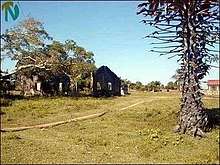Kumarapuram massacre
Kumarapuram massacre also known as 1996 Trincomalee massacre or 1996 Killiveddy massacre refers to the murder of 24 minority Sri Lankan Tamil civilians including 13 women and 9 children below the age of 12 allegedly by the Sri Lankan security forces on February 11, 1996 in a village called Kumarapuram in the eastern district of Trincomalee. Further 28 civilians were severely injured as well. It was a notable mass murder of civilians since the resumption of armed conflict between rebel forces and Sri Lankan armed forces since April 1995 as part of the Sri Lankan civil war. The then government arrested number of soldiers and home guards who allegedly carried out the massacre and a court case was started on 2004.[1][2][3][4][5] On 27 July 2016 the court acquitted six former army Corporals who were accused over the massacre, after they were found not guilty.[6][7]
| Kumarapuram massacre | |
|---|---|
 The ruined village houses of the settlement of Kumarapuram. The location of the massacre of civilians | |
| Location | Kumarapuram, Trincomalee district, Sri Lanka |
| Date | February 11, 1996 (+6 GMT) |
| Target | Sri Lankan Tamil civilians |
Attack type | Firing, Rape |
| Weapons | Guns |
| Deaths | 24 |
| Injured | 28 |
Background information
During the British colonial period, approximately 60% civil service jobs were held by the minority Sri Lankan Tamils. They constituted approximately 15% of the population prior to 1948. This was due to the availability of Western style education as provided by the Protestant American missionaries, Hindu revivalists and local Catholic mission in the Tamil dominant Jaffna peninsula. After gaining independence from Britain in 1948, Sinhalese politicians made the apparent over representation a political issue. They initiated measures aimed at correcting the over representation by establishing ethnic quotas for University entrants. These measures, and a series of riots and pogroms starting from 1958 that targeted Sri Lankan Tamils and the resultant mass murder, displacements and refugees, led to the formation of rebel groups advocating independence for Sri Lankan Tamils. After the 1983 Black July pogrom, full scale civil war erupted between the government and the rebel groups.[8] During the course of the civil war there were number of massacres of civilians, war rapes, torture and enforced disappearances attributed to both the government and allied groups as well as the various rebel formations.
The Massacre
It took place at Kumarapuram, Trincomalee district, on February 11, 1996. According to several survivors interviewed by Amnesty International, 24 civilians, including 13 women and seven children below the age of 12, were killed by soldiers from the 58th mile post and Dehiwatte army camps, accompanied by Home Guards from Dehiwatte. Home guards are local civilians drafted as para-military by the government of Sri Lanka.[1]
The killings were in apparent reprisal for the killings by the rebel Liberation Tigers of Tamil Eelam (LTTE) of two soldiers near a location called the 58th mile post on February 11, 1996 about half an hour earlier. According to one witness, a group of soldiers, some of whom were drunk, gathered at Dehiwatte junction and then proceeded towards Kumarapuram, shouting "death to the Tamils".[2] The villagers of Kumarapuram had taken refuge inside their houses. The soldiers broke open the shutters and aimed their guns at the people hiding inside. One woman recounted how she pleaded with them not to shoot but to no avail. In her house, seven people were killed, including a six-year-old child.[1]
Rapes and murder
Among the victims was 17-year-old Arumaithurai Tharmaletchumi. She was dragged from a boutique in the village and taken to the milk collection centre where she was raped before being shot. Antony Joseph, a 14-year-old boy, who tried to stop the soldiers from dragging her away, was shot between his legs.[1] There were reports of one more rape and murder as well. In total two girls were raped and murdered as part of the massacre.[9]
Government Investigation
The trial of the Kumarapuram massacre has been pending at the Trincomalee High Court. All the accused have been released on bail while one of the accused soldiers died. All material evidence, including weapons allegedly used in the killing of Tamil civilians in the Kumarapuram massacre, were destroyed when the office of the Government Analyst in Colombo was gutted by fire in 2004.[10][11]
Notes
According to University Teachers for Human Rights (UTHR), there was another notable massacre in the same vicinity in 1985 and it is known as the Killiveddy massacre. Sometimes the Kumamarapuram massacre of 1996 is also referred to as Killiveddy massacre.
References
- "Amnesty International report".
- "Report on Kumarapuram massacre". Archived from the original on 2006-10-04.
- "probe Trincomalee massacre".
- "HRW Report".
- "Kumarapuram village".
- "Six army officers acquitted over Kumarapuram massacre". Ada Derana. 27 July 2016. Retrieved 28 July 2016.
- "Court acquits former Sri Lankan army officers accused of Kumarapuram massacre". colombopage. 27 July 2016. Retrieved 28 July 2016.
- "Tamil Alienation". Russell R. Ross. Retrieved 2008-05-08.
- Improving Civilian Protection in Sri Lanka. Human Rights Watch. September 2006. HRW2006.
- "The Bindunuwewa Massacre in Sri Lanka: A Cry for Justice".
- "Kumarapuram victims remembered".,